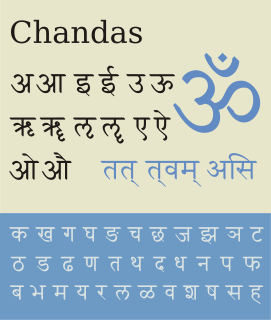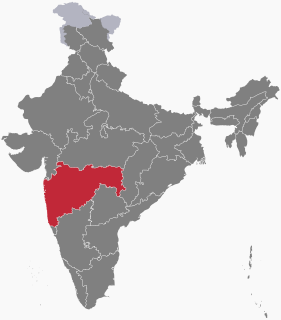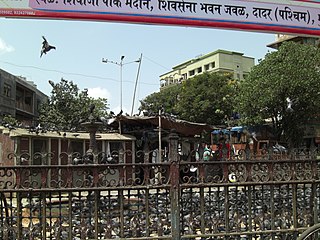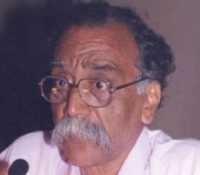This article has multiple issues. Please help improve it or discuss these issues on the talk page . (Learn how and when to remove these template messages) (Learn how and when to remove this template message)
|
Prabhakar Narayan alias Bhau Padhye (Devanagari: प्रभाकर नारायण उर्फ भाऊ पाध्ये) (1926–1996) was an Indian writer who wrote in Marathi. Padhye is regarded as one of the foremost writers to have emerged in not just modern Marathi literature but also Indian Literature, at large. [1] [2] [3] [4] [5] Dilip Chitre once commented that Padhye is a writer "who deserves a permanent place in World Literature".

Devanagari, also called Nagari, is a left-to-right abugida (alphasyllabary), based on the ancient Brāhmī script, used in the Indian subcontinent. It was developed in ancient India from the 1st to the 4th century CE, and was in regular use by the 7th century CE. The Devanagari script, composed of 47 primary characters including 14 vowels and 33 consonants, is one of the most adopted writing systems in the world, being used for over 120 languages. The ancient Nagari script for Sanskrit had two additional consonantal characters.

Marathi is an Indo-Aryan language spoken predominantly by around 83 million Marathi people of Maharashtra, India. It is the official language and co-official language in the Maharashtra and Goa states of Western India, respectively, and is one of the 22 scheduled languages of India. There were 83 million speakers in 2011; Marathi ranks 19th in the list of most spoken languages in the world. Marathi has the third largest number of native speakers in India, after Hindi and Bengali. Marathi has some of the oldest literature of all modern Indian languages, dating from about 900 AD. The major dialects of Marathi are Standard Marathi and the Varhadi dialect. Koli, Malvani Konkani has been heavily influenced by Marathi varieties.
Marathi literature is the body of literature of Marathi, an Indo-Aryan language spoken mainly in the Indian state of Maharashtra and written in the Devanagari script.
Contents
- Literary works
- Novels
- Story collections
- Play
- Movie script
- Other writings
- Literary accolades
- References
- External links
During his lifetime, Padhye had a long ending tussle with publication of his books. Nevertheless, his novels Barrister Aniruddha Dhopeshvarkar, Vasunaka, Rada are regarded as classics of modern Marathi literature. Padhye was also known for his short stories. A collection of his short stories was edited by Dilip Chitre. Another collection of his selected short stories was edited by Rajan Gavas.
His third published novel Vasunaka (Devanagari: वासूनाका) polarized critics in Maharashtra. Writers including Vijay Tendulkar, Durga Bhagwat hailed the novel for its originality and its portrayal of humanism. On the other hand, critics like Acharya Atre shamed the novel for its vulgarity.

Maharashtra is a state considered to be part of western, central, southern and south-central India. It is the second-most populous state and third-largest state by area in India. Spread over 307,713 km2 (118,809 sq mi), it is bordered by the Arabian Sea to the west, the Indian states of Karnataka and Goa to the south, Telangana and Chhattisgarh to the east, Gujarat and Dadra and Nagar Haveli to the north west, and Madhya Pradesh to the north. It is also the world's second-most populous subnational entity. It was formed by merging the western and south-western parts of the Bombay State, Berar and Vidarbha, and the north-western parts of the Hyderabad State and splitting Saurashtra by the States Reorganisation Act. It has over 112 million inhabitants and its capital, Mumbai, has a population around 18 million making it the most populous urban area in India. Nagpur hosts the winter session of the state legislature. Pune is known as 'Oxford of the East' due to the presence of several well-known educational institutions.

Vijay Dhondopant Tendulkar was a leading Indian playwright, movie and television writer, literary essayist, political journalist, and social commentator primarily in Marāthi. He is best known for his plays Shantata! Court Chalu Aahe (1967), Ghāshirām Kotwāl (1972), and Sakhārām Binder (1972). Many of Tendulkar's plays derived inspiration from real-life incidents or social upheavals, which provides clear light on harsh realities. He has provided guidance to students studying "play writing" in US universities. For over five decades Tendulkar had been a highly influential dramatist and theatre personality in Mahārāshtra.

Durga Narayan Bhagwat, popularly known as Durga Bhagwat, was an Indian scholar, socialist and writer. She studied Sanskrit and Buddhist literature and spent time in the jungles of Madhya Pradesh to study tribal life. She later returned to Mumbai as a researcher and wrote books in Marathi. She is arguably the foremost female writer in Marathi. Shes one amongst the prominent writers who opposed The Emergency (India). She also abstained from accepting such institutional and civilian honours as the Padma Shree and the Jnanapeeth.
Padhye graduated in Economics from the University of Mumbai in 1948. During 1949-51, he worked as a full-time volunteer for a labour union. He worked next as a teacher in King George High-school at Dadar, L. Kaduri High School at Mazgaon, and B. S. Ezikel High School at Sandhurst Road, all in Mumbai, for a year each. Then he worked for four years as a clerk in Spring Mill at Wadala in Mumbai before starting his career as a journalist, sequentially in Hind Mazdoor, Nava Kal, and Nava Shakti dailies.

The University of Mumbai, informally known as (MU), is one of the earliest state universities in India and the oldest in Maharashtra. It offers Bachelors, Masters and Doctoral courses, as well as diplomas and certificates in many disciplines like the Arts, commerce, Science, Medical and Engineering. The language of instruction for most courses is English. The University of Mumbai has three campuses across Mumbai and one outside Mumbai. The Fort campus carries out administrative work only. Several institutes in Mumbai previously affiliated to the university are now autonomous institutes or universities. The University of Mumbai is one of the largest universities in the world. In 2011, the total number of enrolled students was 549,432. The University of Mumbai currently has 711 affiliated colleges.

Dadar is the first planned suburb of Mumbai. It is a densely populated residential and shopping neighbourhood. It is also a prominent railway and bus service hub with local and national connectivity. Dadar is also a hub for the immigrant Marathi culture, which gradually replaced the native East Indian one, in Mumbai.
His columns were published in different Marathi magazines, including Rahasyaranjan, Abhiruchee, Manoos, Sobat, Dinank, Kridangan, and Chandrayug.
In 1989, Padhye suffered an attack of paralysis.
He was married to Shoshna Mazgoankar , a labour union activist



